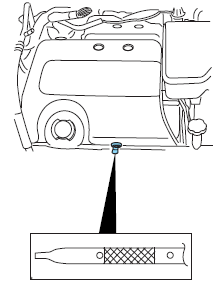Checking the engine oil

Refer to the scheduled maintenance information for the appropriate intervals for checking the engine oil.
1. Make sure the vehicle is on level ground.
2. Turn the engine off and wait 15 minutes for the oil to drain into the
oil pan.
3. Set the parking brake and ensure the gearshift is securely latched in P
(Park).
4. Open the hood. Protect yourself from engine heat.
5. Locate and carefully remove the engine oil level dipstick.
6. Wipe the dipstick clean. Insert
the dipstick fully, then remove it
again.

Х If the oil level is within this range, the oil level is acceptable.
DO NOT ADD OIL.

Х If the oil level is below this mark, engine oil must be added to raise the level within the normal operating range.

Х If required, add engine oil to the engine. Refer to Adding engine oil
in this chapter.
Х Do not overfill the engine
with oil. Oil levels above this
mark may cause engine
damage. If the engine is
overfilled, some oil must be
removed from the engine by an
authorized dealer.

7. Put the dipstick back in and ensure it is fully seated.
See also:
If Your Vehicle Gets Stuck in Mud or Snow
Note: Do not rock the vehicle if the engine is not at normal operating
temperature or damage to the transmission may occur.
Note: Do not rock the vehicle for more than a minute or damage to the
t ...
Belt-Minder
The Belt-Minder feature is a supplemental warning to the safety belt
warning function. This feature provides additional reminders by
intermittently sounding a chime and illuminating the safety bel ...
Engine coolant change record
Engine coolant change log
...
